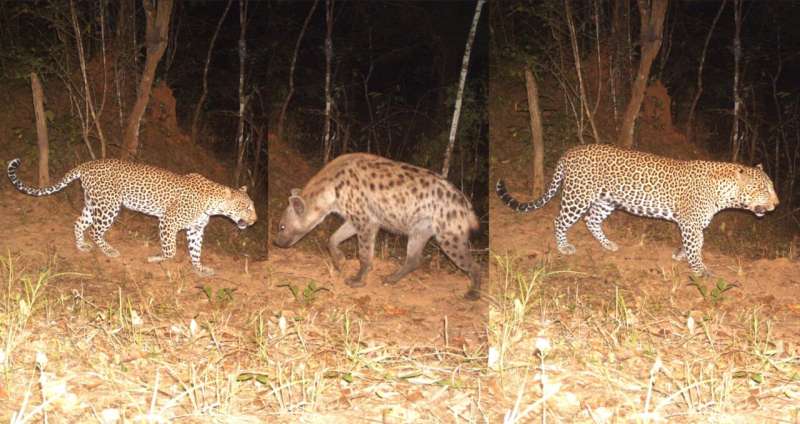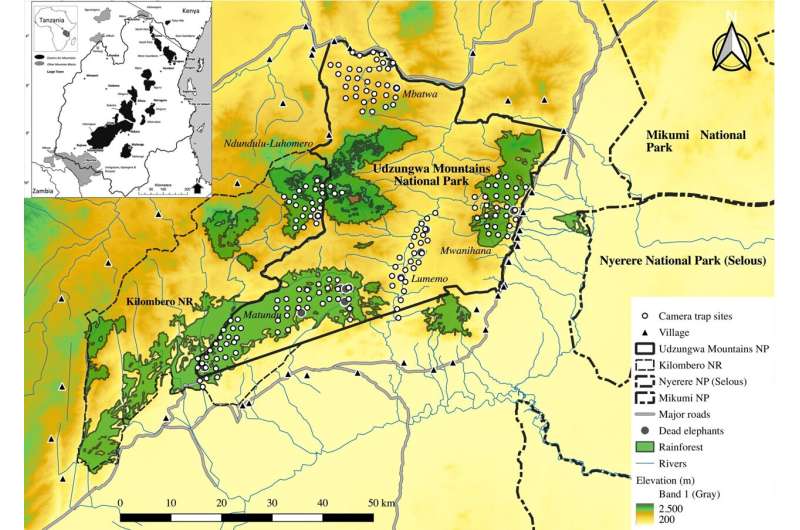
Images taken by camera traps in Udzungwa. From left to right: female leopard, hyena, male leopard. Credit: Rasmus W. Havmøller
Who is stronger? A lone leopard or a group of hyenas? And who gets along best with humans?
Researchers from the University of Copenhagen studied this phenomenon closely in a large natural area of East Africa surrounded by rural areas. The study published in Ecospheredemonstrates that human presence has a direct impact on the competitive relationship between two large predator species: the leopard (Panthera pardus) – the iconic spotted feline and the spotted hyena (Crocuta crocuta) – a kleptoparasite and pack hunter known for its comical appearance and characteristic “laugh”.
“We humans continue to chip away at the little wilderness that remains in the world. In doing so, we are impacting wildlife. This study shows that human disturbances upset the balance between competing species and that this benefits hyenas,” says Rasmus W. Havmøller, first author of the study and a postdoctoral fellow at the Natural History Museum of Denmark at the University of Copenhagen.
For months, Havmøller has been using camera traps to observe the dynamics between hyenas and leopards living in the Udzungwa Mountains in Tanzania, about 2,000 km away2 National park entirely surrounded by agricultural and populated areas. This study is the first to combine camera observations of large predators across time and space in a single analysis.
While the hyena appears to be an increasing species, the leopard population has been in significant decline for decades, both in Africa and around the world. Since hyenas are the only competitors of leopards in this particular natural area, the ability of the two species to coexist is important for their survival. And here, the local population is an important factor.
“Because local people don’t like leopards, they retreat as far away from humans as possible. Hyenas, on the other hand, take advantage of the fact that humans don’t feel threatened by them and don’t chase them. As a result, hyenas live close to human populations and can even use humans as shields against leopards,” says Havmøller.
“But the areas closest to humans are also where there is the most prey. And as hyenas assert dominance over these areas, this increases their ability to outcompete leopards and potentially threaten the latter’s adaptability,” Havmøller adds.
Size questions
The researchers’ observations confirm that size matters. While larger male leopards maintain their dominance over hyenas, the situation is different for smaller female leopards.
“Even though the male leopards are in charge, the hyenas are not really afraid of them. They just stay back, probably to follow the leopards and steal their prey. But the hyenas’ physical inferiority seems to be compensated for in areas closer to humans, because the male leopards retreat,” Havmøller says.
“Female leopards, on the other hand, completely change their behavior when hyenas are in the area. They become diurnal, while hyenas are primarily nocturnal. This is probably because female leopards are smaller than hyenas and tend to lose any fight for prey.”
Overall, the study shows that hyenas benefit from living in close proximity to humans.
“This suggests that the hyena’s ability to adapt to areas of human activity may enhance its overall success as a species and its competitive advantage over other large predators as we humans increasingly disrupt nature,” Havmøller says.

Map of Udzungwa Mountains, Tanzania. Credit: Ecosphere (2024). DOI: 10.1002/ecs2.4913
When leopards are under pressure, cascading effects can follow.
According to the researcher, the change in the hunting habits of female leopards could have negative consequences. “If you open up the national park more to tourism and build more roads, the female leopards will immediately be under pressure. They are not able to differentiate between safari tourists, who are more active during the day, and poachers.”
“Over time, they will probably learn that safari visitors are not dangerous. But if there is a large and rapid influx into the area, you will probably see a decline in their population,” Havmøller says.
If leopards are seriously pushed out of the food chain, we can expect what are called cascading effects in the ecosystem. “The removal of a large predator like the leopard from the food chain, which can be the ultimate consequence of human disturbance, can have very violent effects.
“Populations of other species, such as some monkeys, whose populations are controlled by leopards, will suddenly become too large and change the balance of the entire ecosystem,” explains the researcher.
Havmøller hopes the study will encourage restraint in the management of wilderness areas.
“Our results clearly indicate that human disturbance can alter the competitive relationship between top predators, so I hope that considerations will be given when expanding activities into wild areas to roll them out gradually and give animals a chance to adapt.
“It would also be wise to monitor the effects of human disturbance in more places using camera traps,” Havmøller concludes.
Hyenas vs Leopards
- Leopards are unpopular among local people in many places because they can hunt livestock and attack humans. Hyenas, on the other hand, “clean up” by eating sick or dead livestock and pose no problem to humans.
- Female leopards (about 20–43 kg) weigh about half the size of male leopards (about 51–72 kg). Hyenas are about average in weight (about 48–56 kg).
- Leopards are solitary hunters, while hyenas hunt in large groups (clans), which can be an advantage for hyenas in confrontations with leopards.
- Hyenas are kleptoparasites that regularly steal prey from other carnivores, including leopards.
- Leopards, on the other hand, are excellent tree climbers, which allows them to protect their prey from hyenas.
More information:
Rasmus Worsøe Havmøller et al, Sex and size matter: complex dominance relationships in an East African large carnivore guild, Ecosphere (2024). DOI: 10.1002/ecs2.4913
Provided by the University of Copenhagen
Quote:Human Presence Shifts Balance Between Leopards and Hyenas in East Africa (2024, July 2) Retrieved July 3, 2024 from https://phys.org/news/2024-07-human-presence-shifts-leopards-hyenas.html
This document is subject to copyright. Apart from any fair dealing for the purpose of private study or research, no part may be reproduced without written permission. The content is provided for informational purposes only.